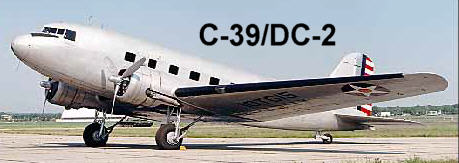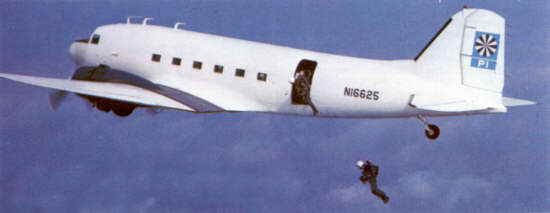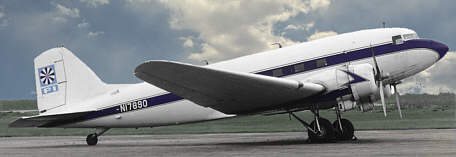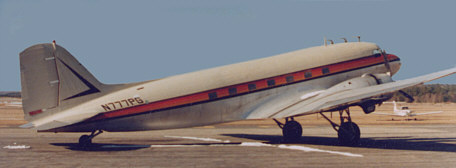| PI
pioneered the used of large aircraft for sport jumping with the Norseman
and was also the first Drop Zone to use the DC-3 or C-47 for jumping.
The first use was in September 1963 when PI realized that more and more
jumpers were actually staying in the sport and were making higher and higher
jumps.
The Norseman at Orange usually took about an hour to bring 10 jumpers to 12,500' AGL and needed an aircraft that would get them there faster and put out more loads in a day. Marge Bates recalls her first DC-3 jumps on Sept 15, 1963 (CLICK here). Our iInformation is vague at this point but it appears that PI rented DC-3's in 1961 and 1963 for use at Orange. Marge recalss one being there for one weekend in 1961 when she started jumping. It's very possible that PI was reacting the use of the DC-3 in California by "POP" Poppenhager's DZ. Elizabeth Foster (then B-3126) jumped a DC-3 there in December 1961 and wrote that it had been there for previous jumps. In
the western world, there are four great multi-engine jump planes that have
seen thousands upon thousands of jumps.
IN World War II, the C-47/Dekota was used by the USA, Canada, Britain, South Africa, Australia, New Zealand, Russia, France and even Japan and Germany had some DC-3's bought before the war that they occasionally used. The famous unit KG-200 (Nazi Germany) used the C-47/DC-3 to parachute spies into Allied territory for over 2 years! They were used in Korea (along with the C-119 Box Car which replaced the WW2 C-46) as well as in the Middle East and Viet Nam where the American, French and Vietnamese used them.
The DC-3 is a further development of the DC-2 (1934) which was also the Air Force C-39 and C-42. The DC-2 was derived from the DC-1 (1933). You can tell the difference between them by comparing the engines and the veerticle stabilizer. General MacArthur's personal plane was a DC-2/C-39 and it is still flying today. The airliner was in service when WW2 started and the USAAF seconded quite a few of them and converted Douglas DC-3 production to C-47's. Their last use by the USAF was in Viet Nam where they became the AC-47 Gunship, armed with 3 side firing .30 cal. mini-guns firing 6000 rds. a minute each. They were augmented and later replaced by the AC-119 and AC-130 gunships. The "D" model of the C-47 was the most numerous. 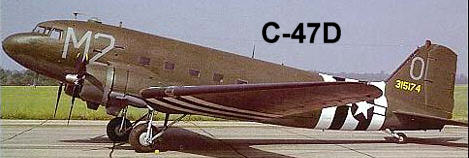 The C-47/DC-3 is still in use in many places around the world and some have been converted to turbine engines. The main conversion was the Conroy Kit by Conroy Aviation of Santa Barbara, California. Conroy was the designer of the "GUPPIES" and broke away from Aerospace Lines to form his own company at Santa Barbara Airport in Goleta (also the home of the Guppies) in 1969. The Conroy kits were mainly sold in South America and used the Royles Royce DART engine. It came in a two or three-engine kit, the third DART being installed in the nose. Two South American Countries still use the Conroy DC-3's for maritime patrols, feathering one engine to increase loiter time and range. Because the DART is considerably lighter than the original radial engine, it had to be extended far forward to maintain the original weight and balance. PI had five different DC-3's. The second, as noted in Marge's story, was a rented DC-3 executive plane still in it's posh dressing. It was also white like the next 3 DC-3's. In 1972, Jacques found three DC-3's in Texas and moved them to Orange. Vic Villa was the main DC-3 pilot plus Cliff Robbins (a retired Northeast Airlines captain living in Orange and DC-3 check pilot for PI) and co-pilotRon Anusiewicz. Ron flew the DC-3's at Orange and Elsinore. Of the three later DC-3's only one (N16625) is still on the FAA register and is flying in Wildomar, California. 625 was used mostly at Lakewood with side trips to Orange and it was finally moved to Elsinore, and was perminantly stationed in Elesinore when PI folded.. One of the three was an absolute gem mechanically while the other two were adequately sound but with minor problems including landing gear. When it became clear that large stars were the thing of the future The
DC-3's first flew at Orange, then Lakewood and at least 2 were stationed
at Elsinore till PI folded.
|

